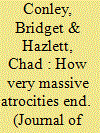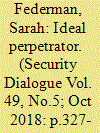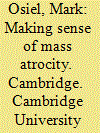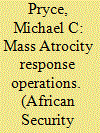| Srl | Item |
| 1 |
ID:
178735


|
|
|
|
|
| Summary/Abstract |
Understanding how the most severe mass atrocities have historically come to an end may aid in designing policy interventions to more rapidly terminate future episodes. To facilitate research in this area, we construct a new dataset covering all 43 very large mass atrocities perpetrated by governments or non-state actors since 1945 with at least 50,000 civilian fatalities. This article introduces and summarizes these data, including an inductively generated typology of three major ending types: those in which (i) violence is carried out to its intended conclusion (37%); (ii) the perpetrator is driven out of power militarily (26%); or (iii) the perpetrator shifts to a different strategy no longer involving mass atrocities against civilians (37%). We find that international actors play a range of important roles in endings, often involving encouragement and support for policy changes that reduce mass killings. Endings could be attributed principally to armed foreign interventions in only four cases, three of which involved regime change. Within the cases we study, no ending was attributable to a neutral peacekeeping mission.
|
|
|
|
|
|
|
|
|
|
|
|
|
|
|
|
| 2 |
ID:
161491


|
|
|
|
|
| Summary/Abstract |
Mass atrocity requires the participation of numerous individuals and groups, yet only a few find themselves held accountable. How are these few selected? This article offers a framework that is useful for understanding how the condemned often embody attributes that keep them in the spotlight. Because norms used to identify perpetrators can set the context for future violence, long-term security requires interrupting both the actions of perpetrators and the discourses about them. A form of praxis, this study of the contemporary conflict over the French National Railways’ (SNCF) amends-making for its World War II transport of deportees towards death camps considers how certain perpetrators come to stand for the many. The SNCF remains in the spotlight not because of greater culpability or an unwillingness to make amends but because it embodies attributes of an ‘ideal’ perpetrator: it is (1) strong, (2) abstractable, (3) representative of the nature of the crime, and (4) has a champion-opponent who focuses attention on the perpetrator. Understanding the labeling process makes visible who and what we ignore at our own peril.
|
|
|
|
|
|
|
|
|
|
|
|
|
|
|
|
| 3 |
ID:
098308


|
|
|
|
|
| Publication |
Cambridge, Cambridge University Press, 2009.
|
| Description |
xviii, 257p.
|
| Standard Number |
9780521861854, hbk
|
|
|
|
|
|
|
|
|
|
|
|
Copies: C:1/I:0,R:0,Q:0
Circulation
| Accession# | Call# | Current Location | Status | Policy | Location |
| 055185 | 345.0235/OSI 055185 | Main | On Shelf | General | |
|
|
|
|
| 4 |
ID:
097716


|
|
|
|
|
| Publication |
2009.
|
| Summary/Abstract |
The Mass Atrocity Response Operations (MARO) Project, a collaboration of Harvard University and the United States Army, focuses traditional military planning on the mission of genocide prevention. This article describes a generic planning framework designed for use by governments, regional peacekeeping organizations and NGOs to coordinate prevention and intervention efforts. This overview of the complex military planning process gives the civilian planner insight and introduces the anti-genocide community to a practical tool for turning rhetoric into considered action.
|
|
|
|
|
|
|
|
|
|
|
|
|
|
|
|